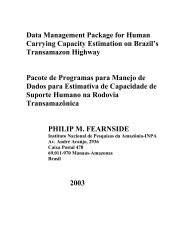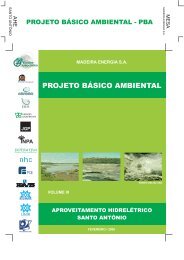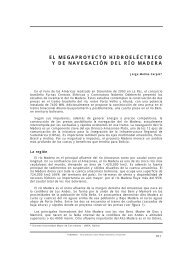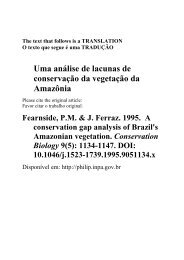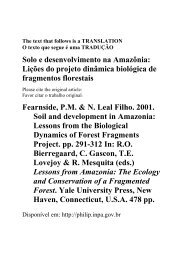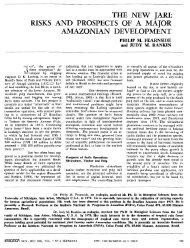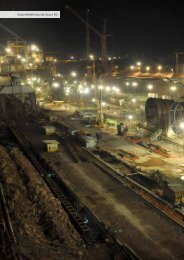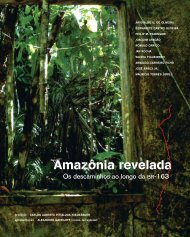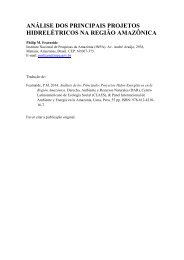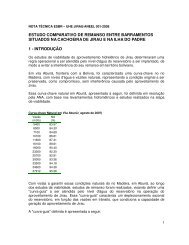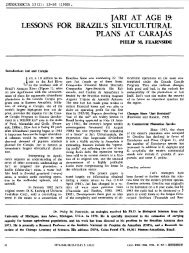THE FUTURE OF THE AMAZON - Philip M. Fearnside - Inpa
THE FUTURE OF THE AMAZON - Philip M. Fearnside - Inpa
THE FUTURE OF THE AMAZON - Philip M. Fearnside - Inpa
Create successful ePaper yourself
Turn your PDF publications into a flip-book with our unique Google optimized e-Paper software.
370-75% of all deforestation in the Brazilian Amazon (<strong>Fearnside</strong> 1993, Nepstad et al.1999a), and account for much forest loss elsewhere in Latin America (e.g. Viña andCavalier 1999).The second major cause of deforestation is slash-and-burn farming, typicallyconducted by small landowners who clear small (1-2 ha) areas of forest each year. Theforest’s understory is slashed with machetes and the debris is ignited during the dryseason. The ash from the burned vegetation provides a brief pulse of plant nutrients,which supports crops for a few years before the area is left to fallow and the farmer isforced to clear more forest. Slash-and-burn farming occurs both opportunistically (oftenillegally) and as a result of government-sponsored colonization programs that allocatesmall forest tracts (50-200 ha) to individual families. Brazil has hundreds of Amazoniancolonization projects involving millions of people, initiated in part to help divertpopulation flows that would otherwise further overcrowd Brazil’s major cities (<strong>Fearnside</strong>1990, 1993).A third cause of deforestation, industrial agriculture, is increasing very rapidly inimportance along the drier southern margins of the Amazon (and also in drier areas inthe east-central Amazon near Santarem) and adjoining transitional forests and cerradowoodlands and savannas. Most of these farms are devoted to soybeans, whichinvolves clearing large expanses of flat land for crop production (<strong>Fearnside</strong> 2001,Steininger et al. 2001a, 2001b).LoggingIndustrial logging is increasing dramatically in the Amazon. Tropical logging is usuallyselective, in that only a small percentage of trees are harvested, although the number ofharvested species varies considerably among regions. In new Amazonian frontiers, forexample, only 5-15 species are typically harvested (1-3 trees/ha), but 100-150 speciesare harvested in older frontiers (5-10 trees/ha)(Uhl et al. 1997). Valuable timbers suchas mahogany (Swietenia spp.) are often overexploited and play a key role in makinglogging operations profitable (<strong>Fearnside</strong> 1997).The direct impacts of logging mostly arise from the networks of roads, tracks, andsmall clearings created during cutting operations (Fig. 2), which cause collateral treemortality, soil erosion and compaction, vine and grass invasions, and microclimaticchanges associated with disruption of the forest canopy (Uhl and Vieira 1989, Verissimoet al. 1992, 1995, Johns 1997). In addition, logging has important indirect effects; bycreating labyrinths of forest roads, logging opens up areas for colonization by migrantsettlers who often use destructive slash-and-burn farming methods (Uhl andBuschbacher 1985, Verissimo et al. 1995, Laurance 2001). Logging also allows a sharpincrease in hunting, which can dramatically affect some wildlife species. In theMalaysian state of Sarawak, for example, one logging camp was estimated to consumeover 30,000 kg of wildlife meat each year (Bennett and Gumal 2001).In recent years, multinational timber companies from Malaysia, Indonesia, SouthKorea, and other Asian countries have moved rapidly into the Brazilian Amazon bybuying large forest tracts, often obtained by purchasing interests in local timber firms. InGuyana, Suriname, and Bolivia, Asian corporations have obtained long-term forestleases (termed "concessions"; Colchester 1994, Sizer and Rice 1995). In 1996 alone,



